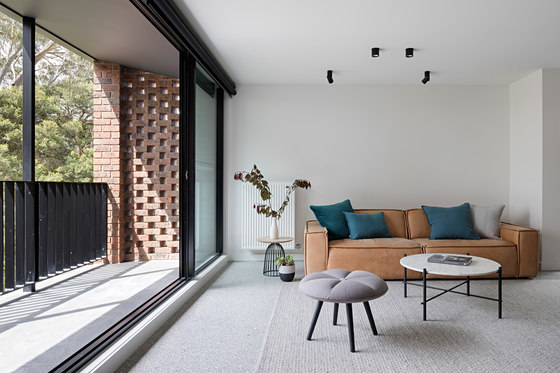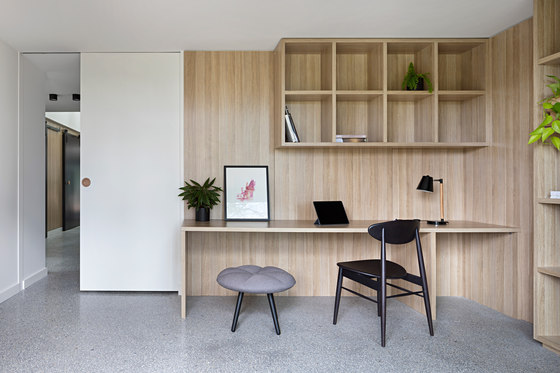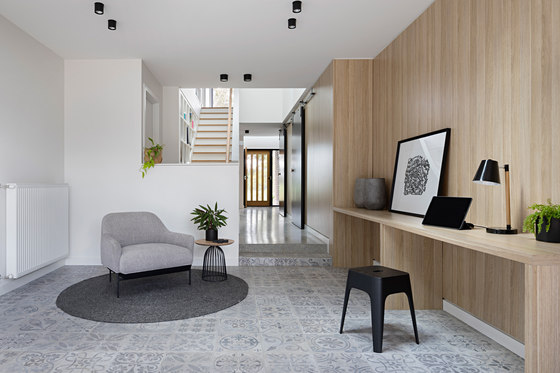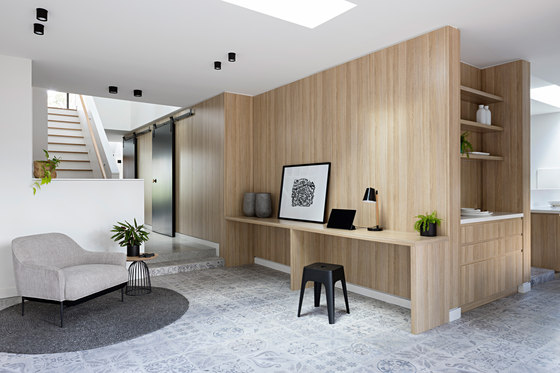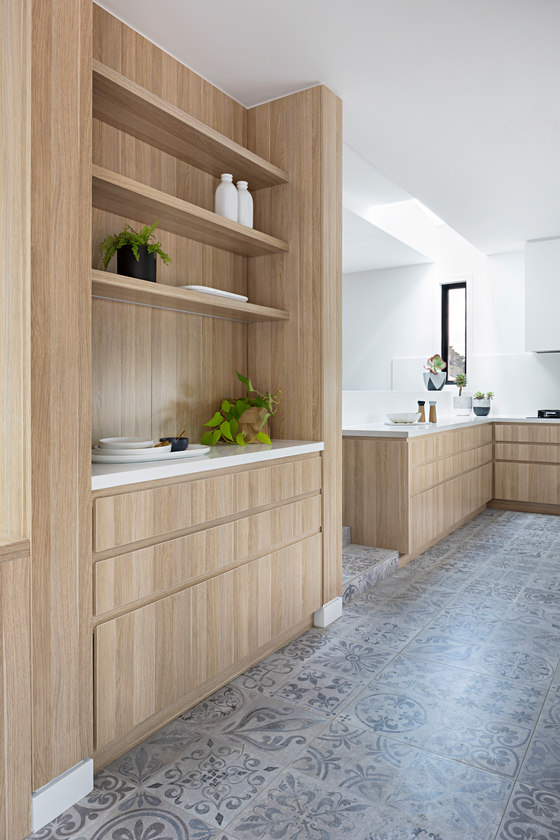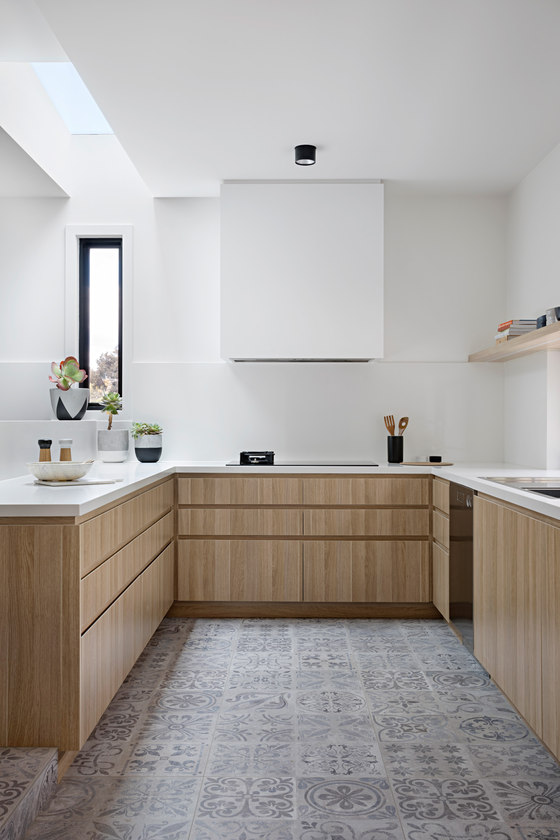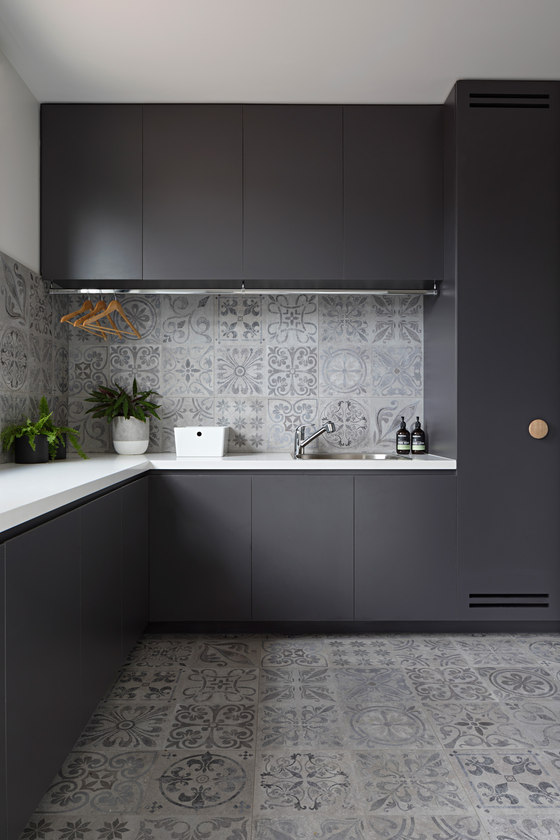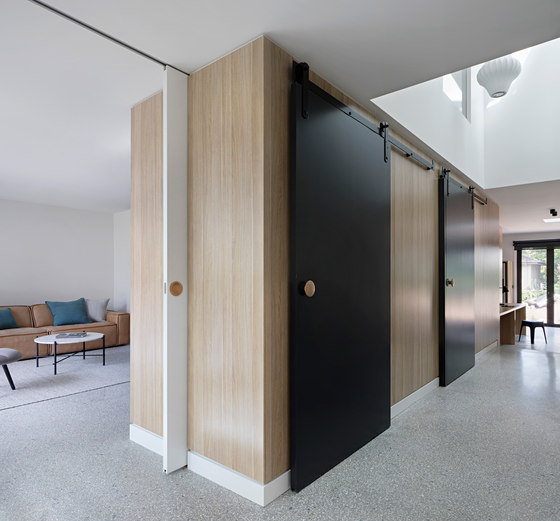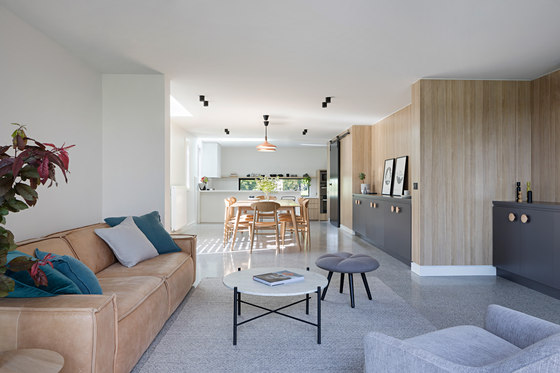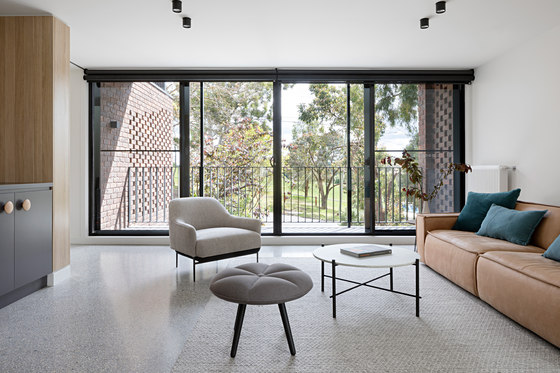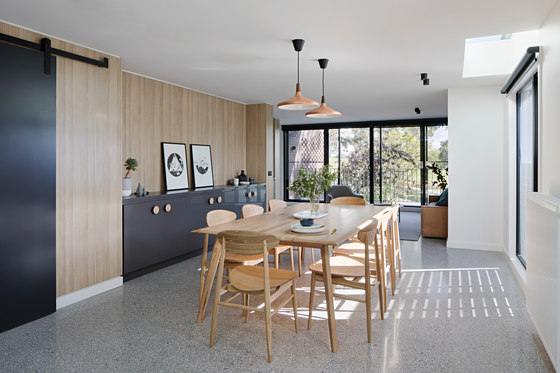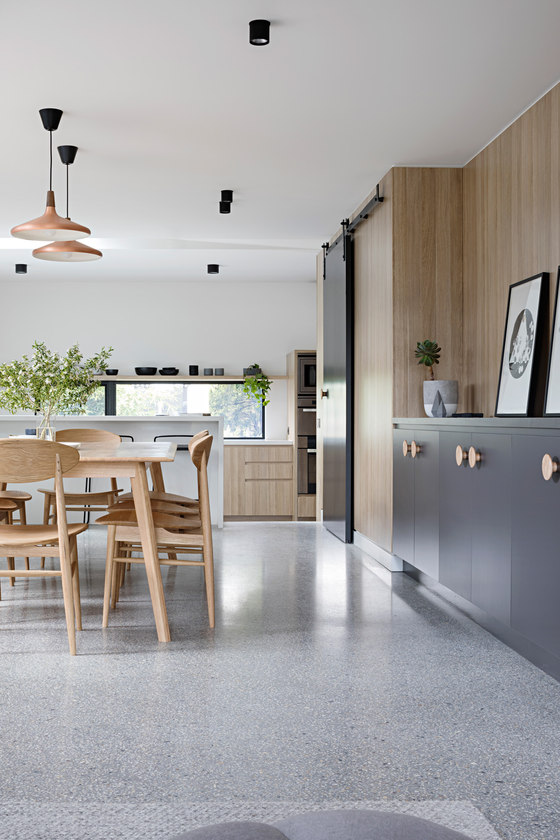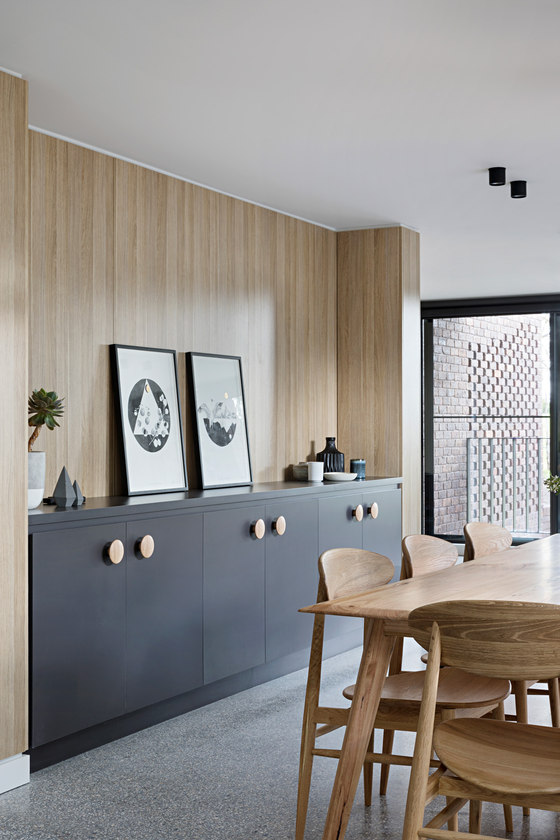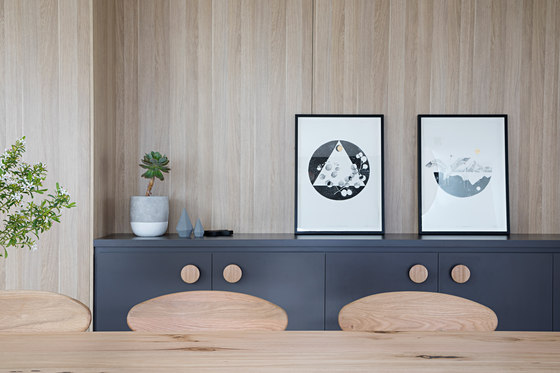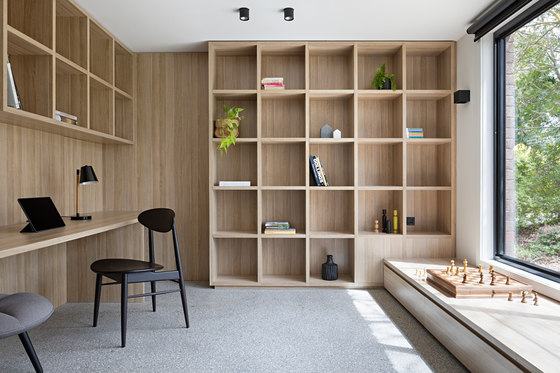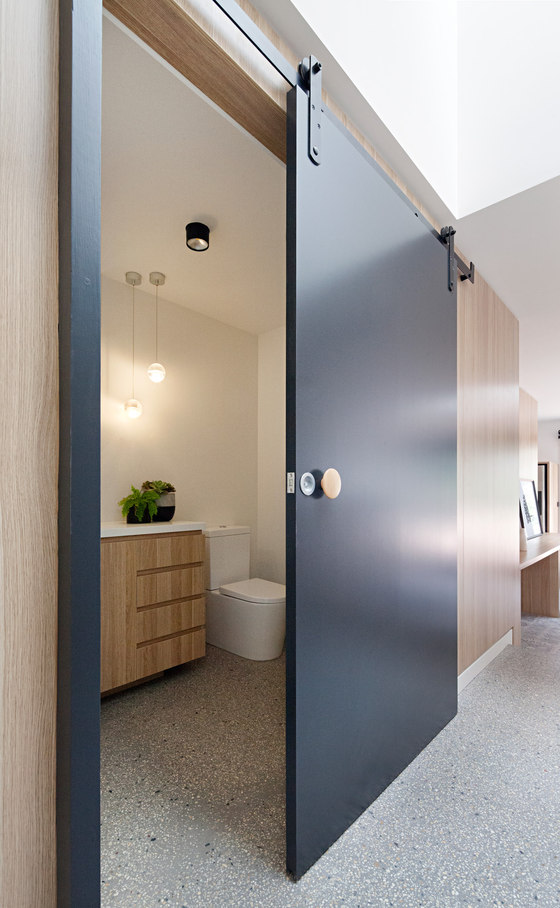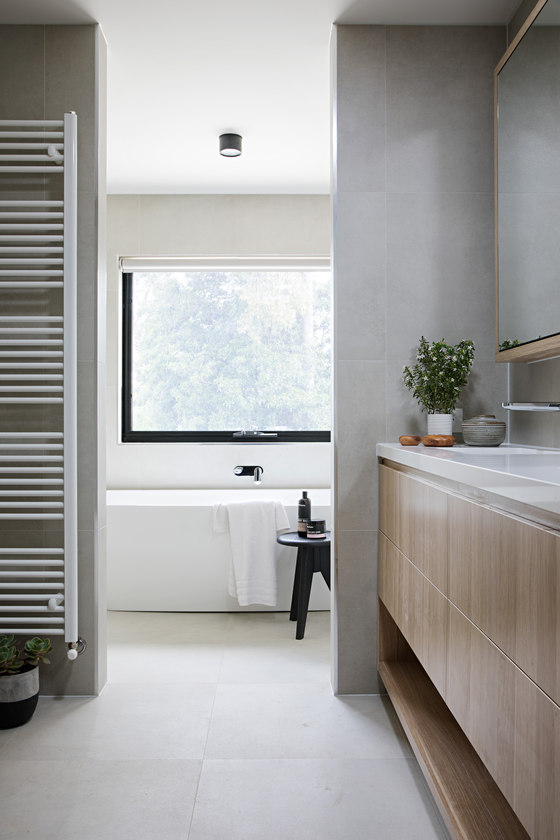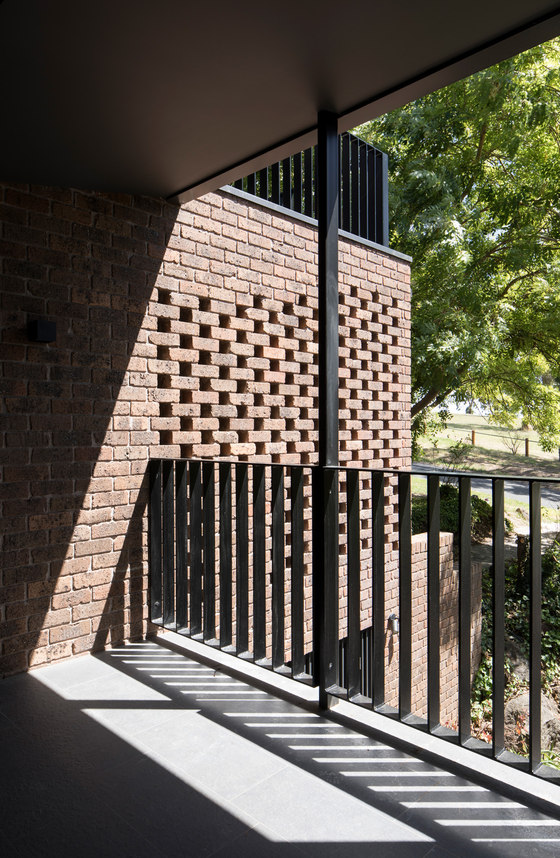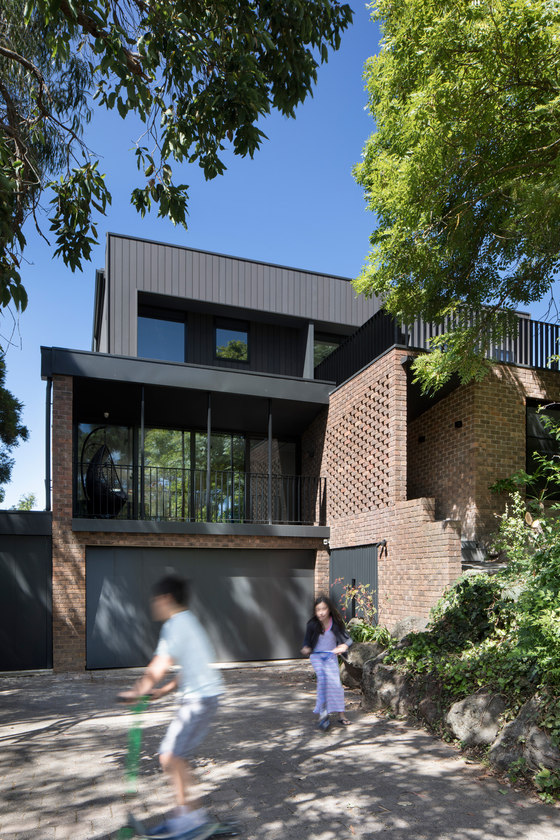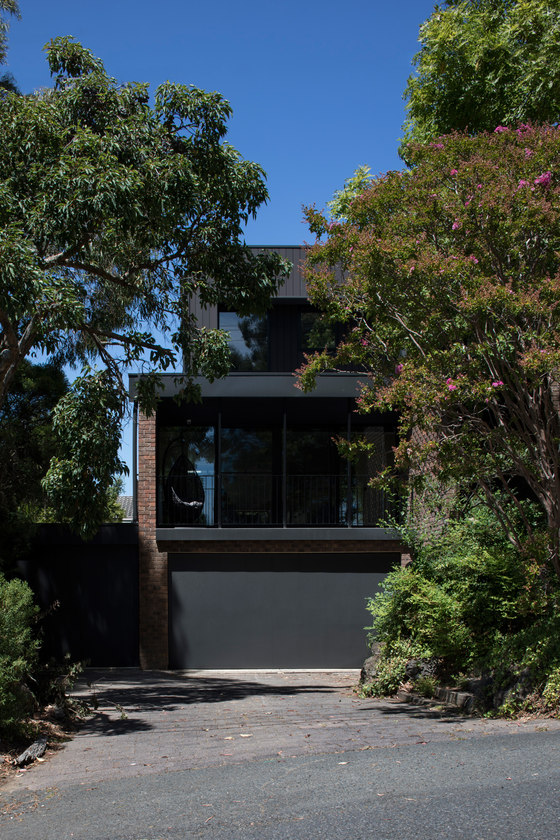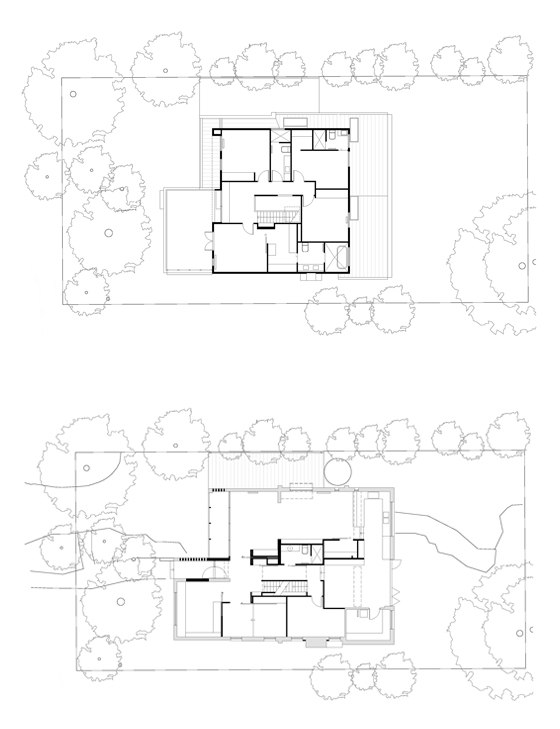To make the most of its privileged position, overlooking Ruffey Lake Park in Doncaster, this 1970s double brick family home has undergone a complete transformation. To take better advantage of its stunning outlook and north-facing frontage, the previously dark and compartmentalised interior has been reconfigured and the upper level rebuilt to deliver abundant natural light, highlight stunning views and provide a seamless connection between kitchen, dining and living spaces, essential to modern family life. Quieter private spaces, such as the library, music room and TV den nestle snugly into the sheltered, west side of the ground floor. A timber-clad pod divides the east and west sides of the floor plate and conceals the cloak room, bathroom and pantry. The new first floor comprises generous bedroom suites, additional bathroom and a large north facing terrace, conveniently accessed from both the landing and master suite.
Clever reworking of existing stepped floor levels and the strategic placement of voids and skylights creates a variety of spatial volumes and brings natural light to core of the home. The central timber stair is lined to one side with custom-shelving to display the occupants’ collections, and the other is open to the double height void – now bathed in sky-lit softness.
The brown brick of the existing house and typical of its era is retained to the ground and basement levels and complimented by new charcoal cladding and trims. The existing fabric is celebrated and updated by the clean lines of the new parapets and window details. The insertion of hit and miss brickwork blurs the distinction between interior and exterior spaces and provides a surprise lightness to the otherwise solid forms.
The solutions and the thought process
• Careful study and planning was undertaken to explore options to fit the spatial requirements within the existing structure. Considerations were given to optimising private and common areas, capturing views, solar access, shading, maximising cross ventilation and minimising circulation.
• In response to the existing deep floor plan, services and amenity on ground floor were consolidated in a central zone. It allowed the living areas (common zones and private zones) to be planned around the periphery of the house to receive most natural light. Dubbed as 'the pod' this central zone was clad in timber-like joinery panels and is comprised of the cloak cupboard, bathroom, rumpus shelf on one side and credenzas (for living and dining), pantry and appliance cupboards on the other side.
• The open living spaces were planned with the living room and kitchen at either end as anchors. The living room connects to the entry space, the library and the media room (each room has the ability to close off with a sliding door when needed). The kitchen is connected to the rear rumpus (access to backyard) and the laundry.
• Front porch: A division between the entry porch and the balcony was proposed to provide better privacy to the living space. The hit-and-miss brickwork (reused bricks salvaged from demolition) was designed to provide privacy to the balcony and living room from visitors or people walking by (blocking off the view from the higher end of the street).
• Balcony: The raked ceiling allowed deeper solar penetration into the living room in winter while providing shading in summer.
• Music room and TV pit: The music room, with an oversized door opening was designed to feel like part of the open living space. Utilising the existing split level in the room, a TV pit was created in the music room with the entertainment cupboard hidden behind the oversized sliding door (to hide all the clutter). The kids would have to shut the door in order to watch TV. And the parents could enjoy their peace and quiet. Killed two birds with one stone!
• The staircase going down to the basement garage was re-oriented so the top landing facing the front door (north). This freed up the rear rumpus space and also meant the occupants always walk up to the brighter part of the house.
• Skylights were strategically positioned around the house; at entry, stair void, dining, kitchen and rumpus. They dissected the ceilings and brought in natural light throughout the day.
• In response to the owner's love for books and reading, the house provided book shelves and casual seat benches in multiple zones.
• The external form was re-imaged as a series of solid and transparent layers stacking over the existing brick structure. Black metalwork and dark brown composite cladding complements the existing brickwork. We wanted the house to blend into the surrounding.
What were some key challenges?
- To knock down or to renovate?
- Deep floor plate: how to utilise the central spaces and bring in natural light?
- Flexibility of spaces. Open spaces with separation when required.
- Stepped floor levels.
- Client's specific requirements. such kitchen needs to serve dining but also need connection to backyard... etc.
- View across the street: How to capitalise on the magnificent view while maintain privacy?
- North facing frontage: How to bring in natural light to the rear of the house?
- How to work with the existing finishes? The old brown brick? To celebrate its history rather than hiding it.
- Stairs between 3 levels
What was the brief?
• 70's double storey house with a basement garage.
• The family of 5 had outgrown the house. The adults and children lacked their own space.
• Deep floor plate with dark interior.
• The frontage faced north with a vast view of Ruffey Lake park reserve. The old balcony connected to the front porch meant the living room curtains were always closed for privacy reason. Missing out on the great view of the park reserve.
• Existing rooms were small and there were lots of redundant and difficult-to-use spaces, eg. a rumpus that was a thoroughfare between kitchen, family room and laundry. Impossible to furnish.
• Dated looking both inside and outside.
• The owners wanted to modernise the house. Bring it into the 21st century. They wanted more natural light, brighter interior, flexible spaces and the ability to see the park reserve across the street.
Before & after
• The existing house comprised of:
- Ground floor: traditional style arrangement of formal living room, dining room, kitchen with meals, family room, a study and the master bedroom suite. There was a balcony outside the living room which was part of the front porch.
- First floor: two bedrooms with a shared bathroom and toilet.
- Basement: garage and workshop.
• The house now comprised of:
- Ground floor: open living, dining and kitchen with a rumpus tucked around the kitchen, a library, a music and TV room, a guest bed /study, laundry and a balcony
- First floor: 4 bedrooms (2 with WIR and ensuite), a shared bathroom, a rumpus and an roof top terrace that overlooks the park reserve across the street.
- Basement: Garage and workshop was retained. New cloak cupboard and shoe cupboards was added.
Who are the clients and what's interesting about them?
A family of five. Couple with three teenagers.
What are the sustainability features?
- The design follows passive solar principles, in particular orientation of windows for optimum solar gain and cross ventilation. Raked roof eave over the north facing balcony allows deeper solar penetration into the living space in winter while provides shading in summer.
- Existing suspended concrete slab retained and insulated for the thermal benefit.
- Phase change material blankets installed to ceilings and internal walls to further enhance temperature stablisation (maintaining indoor temperature at 25 degrees Celcius).
- Reused existing brickwork and structural steel salvaged from demolition.
- New windows and doors with double glazing and improved aluminium frame through out. Aluminium frame opted due to termite zone.
- High spec insulation to walls,roofs and floor.
- Use of surface mounted led lights through out instead of recessed downlights to maintain the integrity of the ceiling insulation.
- Solar heat pump hot water service.
- PV system 5.3kw.
- Rain water harvesting (20,000litre tank) for toilet flushing and gardening use.
- Low VOC internal paint and joinery finishes.
- Composite timber cladding to first floor addition: zero maintenance and termite resistant.
Inbetween Architecture


